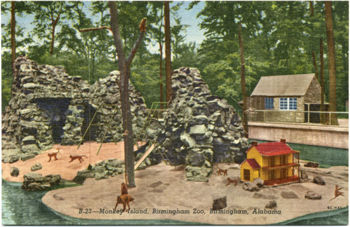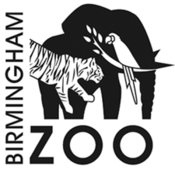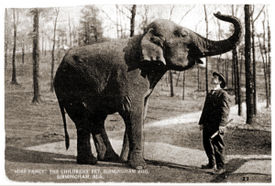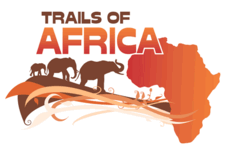Birmingham Zoo
The Birmingham Zoo (formerly the Jimmy Morgan Zoo) is a major zoological park founded in 1955. The 122-acre site is home to approximately 550 animals of 180 species from six continents, including many endangered species. The facility, which is managed by a private non-profit corporation, participates in numerous Species Survival Programs. It is located, along with the Botanical Gardens, in Lane Park near the western terminus of Highway 280 at Highway 31 on the southern slope of Red Mountain.
Earlier zoos
The first documented semi-permanent exotic animal attraction in Birmingham was exhibited at East Lake Park. In 1892 it was reported that the collection included "a bald eagle, a wolf, two pelicans, two deer, a ground hog, two coons, two white rabbits, a kangaroo, seven prairie dogs and a South American anteater."
In 1904 a campaign to raise $1,200 for the purchase of a male elephant was undertaken by city youth as the centerpiece of a "boys' zoological park". A main building to house a variety of animals was being designed by architect William Weston for an undetermined location at a city park, likely Drennen Park. The new elephant would join an existing menagerie kept at the Southside Fire Station under the care of firefighters Cummings and Jason Fox. That collection included "4 red foxes, 3 gray foxes, 4 hawks, 2 young swamp eagles, 2 ring neck doves, 2 crows, 1 prairie wolf, 1 monkey, 1 grayhound, 1 carrier pigeon, 1 muskrat, several white rats, 4 owls and other small animals." It was expected that once a zoo was established, private owners would add to the city's collection. It was concluded that "in a short while Birmingham will have one of the finest zoological parks of any city of equal population in the south."
The project to purchase an elephant did not succeed and Weston's building was never constructed. The animal collection at the fire station was moved to Magnolia Park (now Brother Bryan Park), but eventually neighbors complained about the noise and smell and the remaining animals were dispersed.
Avondale Park
A new zoological garden opened in the southeastern edge of Avondale Park around 1911. Two years later it welcomed Miss Fancy, a former circus elephant. The publicity surrounding the new attraction led members of 16th Street Baptist Church to petition the city to be allowed to picnic at the park one Sunday in 1914. The Birmingham City Commission accepted the petition, and decided to allow all Black residents to visit the park on July 9. Their decision was harshly opposed by the Avondale Civic League, and the church eventually withdrew its request.
With very little more capital investment, the zoo's collection grew slowly and mainly featured indigenous animals. City leaders decided not to act on a proposal to relocate the zoo to Green Springs Park. During the Great Depression, the cost of maintaining the zoo, which averaged about $4,600 a year, was deemed too much to bear, and a committee of the Birmingham Parks & Recreation Board (which included Jimmy Morgan) voted to close the zoo and sell off the collection. Many of the animals were bought by zoos in Augusta, Atlanta, Washington, and Attalla. The Cole Brothers - Clyde Beatty Circus purchased Miss Fancy, along with the zebu, llama, and nine monkeys for a total of $710. During the 1940s, the closest thing Birmingham residents had to a zoo was another small collection of native species exhibited by the Birmingham Chapter of the Izaac Walton League at Lane Park.
Planning the zoo
Birmingham, under mayor A. O. Lane, had purchased land on the south of Red Mountain between 1889 and 1892. The former Red Mountain Cemetery, a pauper's cemetery was part of the parcel that was dedicated as a city park in 1934. The Works Progress Administration built a fish hatchery from the Hartselle sandstone quarried out of the mountain within the park's borders. The hatchery was fed by a natural spring and provided stock for recreational lakes in the region until the zoo took over the park.
The first source of post-war support for a new zoo came from the Birmingham Junior Chamber of Commerce (Jaycees). In 1946 Elton B. Stephens chaired a Jaycees committee to plan for a new zoo attraction. In 1949, then-Mayor of Birmingham, Jimmy Morgan, a key supporter of the development, began an initiative to help in the planning and development of a city zoo. He met early resistance from the Birmingham Parks and Recreation Board and his fellow commissioners, but campaigned tirelessly and oversaw the creation of a committee to formally study the feasibility of a new zoo. That group, which included R. H. McIntosh, Vincent Townsend, H. S. Whisler, Ervin Jackson, and Charles McCauley visited zoos in Atlanta, Georgia; Jackson, Mississippi; Little Rock, Arkansas; and Memphis, Tennessee. They proposed a larger, combined "Alabama Zoological and Botanical Gardens", of which zoo exhibits would make up the first phase.
In 1954 a Birmingham Zoo Advisory Commission was appointed to choose sites, plan exhibits, and prepare budgets for construction. That group was made up of George Bellsnyder, James Downey, Max Scholder, and Ad Club president Bill Spoor and McCauley, the architect. McCauley resigned from the commission in 1955 to be able to provide professional design services for the new buildings.
Despite resistance from Mountain Brook residents, the commission decided that Lane Park was the best of five proposed sites for the new zoo, which would encompass about 50 acres surrounding the existing fish hatchery, accessed from Lane Park Road, and buffered by forest all around. They set a fund raising goal of $250,000, which they projected would allow for construction of the most desirable exhibits (a monkey island, an elephant house, a bear moat, a bird house, a snake pit, and a seal pool). Morgan answered the critics patiently and explained that the zoo the commission was planning would not become an amusement park and would, like the other parks studies, enhance, rather than detract from, its surrounding neighborhoods. A 1954 News article also noted that "modern zoo keeping has completely eliminated animal odors."
The Birmingham Ad Club opened a donation office at 317 20th Street North and carried out the public appeal for donations, airing a jingle on radio advertisements: "You you you! Gonna get a zoo, zoo, zoo! Animals and cages too! Now it all depends on Yo-oo-ou!". Several donations of exotic animals were pledged, including, Leo, a lion cub donated by Metro-Goldwyn-Mayer. Bailiff Andrew Woods, who remembered riding on Miss Fancy as a teenager, made a donation in hopes of once again riding a Birmingham Zoo elephant. Local trade unions promised to provide cheap labor and the Associated Builders and Contractors pledged construction supervision at cost. Despite door-to-door fund-raising appeals with the offer of a chance to name an animal, access to reserved parking spaces, and recognition on a plaque affixed to its cage, significant monetary donations were much slower arriving. By October 24, 1955 only $84,806.09 of the $250,000 wanted had been secured.
Jimmy Morgan Zoo

Undaunted, Morgan had city crews clear underbrush from the 50-acre site and secured assistance from the state in cutting surplus trees. Excavation began in early May 1954. Monkey Island, the first exhibit, was budgeted at $24,000. It opened along with a duck pond on April 2, 1955. The popular monkey attraction, described in the press as a "23-hour-a-day whoop-de-doo," helped spark interest in completing the planned zoo, which was soon dubbed the Jimmy Morgan Zoo against the Mayor's wishes.
Monkey Island was soon joined by an "animal barn" and "wildlife corral" where new additions were kept until permanent exhibits were constructed. Early exotics displayed there included the Susie the chimpanzee and "scores of snakes." The zoo had several African lions in 1955, including a 2-year-old, Leo and a quartet of slightly younger juveniles, Rip, Roar, Rough and Tumble. Another young cub, Accent, was displayed, and two mature lions, Jimmy and Queenie were donated by New Orleans Zoo director George Douglass, but were considered to be "old and infirm" after their arrival in Birmingham. They were sold to the University of Alabama Medical College where they were euthanized by strychnine and embalmed for educational use. The disposal of the pair proved contentious and F. P. Aldridge, president of the Birmingham Humane Society, placed trainer Floyd "Doc" Warner under arrest for failure to provide adequate water to the lions and other animals on exhibit.
Though previously envisioned as a quasi-private enterprise, the city formally took over operations on November 1, 1955 and financed the completion of the exhibits under construction, including the Lion House, Hoofed Animal Barn, Bear Moat, Primate House and Elephant House. These were built basically according to plans first drawn up by McCauley, but many changes were made to the design and details in order to meet the city's tight budgets. $66,300 was set forth for the zoo's first year under city control. Boston Red Sox first baseman and former Birmingham Baron Norm Zauchin donated "Homer", a live brown bear cub which he won by hitting the first home run for the Sox on "State of Maine Day" on May 27.
On Sunday March 3, 1957 the zoo was visited by a group of Ku Klux Klan members wearing hoods and robes. They arrived in 30-40 cars. The leader, dressed in red, told a reporter that the group was making an "unofficial visit" because they had "made donations toward its construction" and wanted to see the result. They spent about 45 minutes touring the zoo before leaving without incident.
A private operator secured a lease to build the first miniature railroad at the zoo that same year. It became the centerpiece of a Kiddie Zoo that opened in 1958 with more than 100 baby animals, many of the displayed in cages built to look like circus wagons. The zoo traded a pair of Siberian Tiger cubs for a pair of Siamese "black panthers" (melanistic leopards) in 1959, displaying them in the primate house. Other private operators managed the zoo's food and drink concessions, giving the city a cut of the profits.
Challenges
In 1960 Bob Truett, former head of the reptile house at Chicago's Lincoln Park Zoo, was hired as the Birmingham Zoo's new director. At the same time, the city floated $1 million in bonds, which paid for the completion of the Giraffe House, Reptile House, and a large flight enclosure for birds. The first admission fee, 50 cents for adults and 25 cents for children aged 12-18, was charged beginning on November 1, 1962.
Despite those efforts, Truett still felt that the zoo was still basically a collection of cheaply-constructed buildings housing "miserable roadside menageries". He criticized the professionalism of his predecessor, a former carnival manager. He reported that animals had been feeding on discards from grocery stores and that some of the keepers had been guilty of cruelty. He began a long process to bring the zoo up to contemporary standards of animal care without much financial support from the city. With care of the collection as the top priority, other parts of the operation suffered such as building maintenance, landscaping and customer service. The inadequacy of the zoo's single 8" diameter sewer main caused repeated flooding and led to the drowning death of a six-day old polar bear cub.
In the early 1960s the City Council created a Birmingham Zoological Society as a fund-raising organization, but donations didn't come close to keeping up with declining appropriations as the city prioritized other needs. Though the animal collection and annual attendance kept growing, the budget shrank. In 1969 the zoo's $297,000 budget was used to pay 28 employees to care for 1,045 animals for the benefit of 415,513 visitors. Truett was vocal about the difficulties of "running a large zoo on a small zoo budget", and threatened to close the zoo for three months a year and sell off animals.
Meanwhile, in 1964, former Mayor Morgan petitioned the Birmingham City Council to remove his name from the zoo, saying that he had never asked for the honor and that it should be named the Birmingham Zoological Garden. Nevertheless, both names were still used well into the 1980s.
1970s expansions
Spurred by Truett's lobbying, the Birmingham Parks & Recreation Board approved $15,520 to commission a 10-Year Master Plan for zoo improvements from Birmingham architects of Felton Collier and Caroll Harmon on January 14, 1971. Their preliminary proposal, presented on October 13 of that year, called for four phases of redevelopment: In the first phase, scheduled for 1971-73, the Children's Zoo would be expanded, a new entrance plaza created, a new expansive "veldt" for hoofed animals with elevated walkways opened, and a central service area constructed. In phase 2, scheduled for completion in 1975, an education and administration building with a lecture hall would be built, along with a new concession stand, additional parking, and an incinerator. In phase 3, ending in 1978, a new big cat area would be constructed near the veldt, accompanied by renovations to the reptile house and completion of the children's zoo. By 1981, the fourth phase would give the zoo a major outdoor rain forest exhibit along with an aquarium with a penguin pool.
Those plans were realized only in part as new appropriations never materialized and private fund-raising efforts fell short. Anna-Lola Water donated $30,000 in memory of her husband, Newman, to help fund the planning and construction of the Newman H. Waters Nocturnal Animal House. Another project to build a new entrance plaza and administrative office, was completed in 1979 at a cost of about $350,000. A wood-sided one-story building wraps three sides of an entrance plaza facing the fish hatcheries. The structure contains classrooms, offices, ticket windows, a gift shop and restrooms.
In March 1991, a few months after long-time director Bob Truett retired and Mike Williamson took on the role of acting director, a team of inspectors from the U.S. Department of Agriculture reported a number of problems requiring immediate attention, including the lack of proper fencing around the property, structural damage to the bear moat, and a shortage of trained personnel. In April, zoo employees cited poor working conditions and threatened to strike.
Noting that the city funded the Zoo and Botanical Gardens while neighboring suburbs benefited from it for free, Birmingham mayor Richard Arrington (who had earned his PhD in zoology), proposed the creation of a regional authority to purchase the park property and manage both attractions. The proposal was opposed by the Birmingham Park and Recreation Board and did not move forward. Meanwhile, appropriations from the city remained scant, and the zoological society did not bring much in the way of leadership. The condition of facilities continued to decline until, in the late 1990s, the American Zoo and Aquarium Association finally withdrew its accreditation.
In 1999, Arrington led the way for privatization of the zoo, recruiting community leaders to serve as the first board of directors of a new organization, Birmingham Zoo, Inc. (BZI) The new organization established a transitional funding package with contributions from four government entities to support BZI during its first five years of operation.
Nonprofit management
BZI undertook an intense 18-month effort to address the most pressing and immediate problems so that the zoo could become accredited by the AZA once again, ranking the Zoo in the top 10% of animal holding facilities in the nation. The Zoo also received 501(c)(3) status from the IRS, and the first major capital campaign was launched in January 2001.
William R. Foster, joined the Zoo as Chief Executive Officer in January 2004. Foster, a veterinarian and leading zoo management authority on the national scene, is president-elect of the American Zoo and Aquarium Association and was president and executive director of the Louisville Zoo.
In the short time following this privatization, the Birmingham Zoo has hosted traveling exhibits of bats, koalas and black-footed penguins, added permanent exhibits of a Komodo dragon and interactive lorikeet aviary, and regained AZA accreditation. The Zoo completed the Junior League of Birmingham-Hugh Kaul Children’s Zoo, a $15 million anchor exhibit dedicated to children and devoted to urban, rural and wild animals and environs of Alabama in April 2005, its 50th anniversary of operation.
The zoo drew a record 574,581 visitors in 2014. The recent low year was 296,102 in 1998 and the previous high was 574,581 in 2013. The largest single-day attendance record was set on March 17, 2009 with 6,845 visitors who got to meet newly-arrived wombats Victoria and Wilbur.
In October 2006 the Zoo was reaccredited by the AZA for the next 5 years. Trails of Africa, the first major expansion of the zoo since the new Children's Zoo, opened in 2010. The 14-acre exhibit realized many of the intentions of the "Veldt" proposal in the 1971 Master Plan. Numerous herbivores share an open grassland and watering areas, separated from predators by unobtrusive barriers. Numerous ecological and cultural exhibits provide educational opportunities for visitors. Unique to the new exhibit is a "bachelor herd" of bull elephants, helping fill a worldwide need for improved captive breeding techniques.
In May 2011 the zoo's African lions welcomed a litter of five cubs, Asha, Baron, Kimba, Lily and Vulcan. The cubs were relocated to others zoos in August 2012. That same year, the zoo became one of the few institutions to successfully hatch a Kori bustard egg when Kobu was born in June.
In 2008 the zoo reported that it was caring for 750 animals of 250 species. By January 2015 that number had grown to 950 animals of 230 species, originating on six continents. In 2021 the zoo claimed 550 animals of 180 species. The zoo's new entrance plaza opened in June 2019.
Attractions/Exhibits
- See also Category:Zoo animals.
Current exhibits
|
Other facilities
Former exhibits
Future exhibits |
Directors
- Clinton Bishop, 1955
- Tom Briskey, 1955-1960
- Bob Truett, 1960-1990
- Jack Throp, 1990-1992
- Mike Williamson (acting), 1992
- Bruce Read, 2000-
- Jerry Wallace
- William Foster, 2004-June 2018
- Chris Pfefferkorn, July 1, 2018-
References
- "Draws Plans for the Zoo Building" (August 3, 1904) The Birmingham Age-Herald, p. 5
- Lilliston, Lyn (April 1954) "Kickoff drive for zoo here to be held Tuesday" The Birmingham News - via Birmingham Rewound
- "Work on first unit of zoo begins this very week!" (May 1954) The Birmingham News - via Birmingham Rewound
- Aldridge, Jane (September 19, 1955) "Missing Lions Turn Up Dead; Zoo Caretaker Under Arrest" Birmingham Post-Herald - via Birmingham Public Library Digital Collections
- Aldridge, Jane (September 21, 1955) "New Orleans Zoo Man Says Lions 'In Prime'." Birmingham Post-Herald - via [https://www.cobpl.org/resources/Digital.aspx Birmingham Public Library Digital Collections
- Lake, Clancy (September 28, 1955) "Park Board makes ready to run zoo" The Birmingham News, p. 36
- "Klansmen Visit The Animals" (March 7, 1957) Birmingham Post-Herald - via Birmingham Public Library Digital Collections
- "Looking back: Lake Como, East Lake, 1887" (October 18, 1959) The Birmingham News - via Birmingham Public Library Digital Collections
- "Admission charges for zoo approved" (October 24, 1962) The Birmingham News - via Birmingham Public Library Digital Collections
- Spotswood, Frances (April 26, 1964) "Asks Change of Zoo Name" The Birmingham News - via Birmingham Public Library Digital Collections
- Hogan, Ben (January 1969) "To 'Mr. Birmingham' the zoo is his trophy" The Birmingham News - via Birmingham Rewound
- Wilson, Mary Booth (December 21, 1969) "Jimmy Morgan Zoo needs lots of money." The Birmingham News
- Isaacson, Dot (October 1971) "Sewage woes, growth pains plague Jimmy Morgan Zoo" The Birmingham News - via Birmingham Rewound
- Johnson, John W. (1972) "A History of Birmingham's Zoos". Urban Studies 102. University of Alabama at Birmingham - at the Birmingham Public Library
- Reeves, Garland (January 1975) "Big donation assures zoo nocturnal building" The Birmingham News - via Birmingham Rewound
- "Birmingham Zoo" (May 9, 2006) Wikipedia - accessed May 9, 2006
- HIckerson, Patrick. (May 9, 2006) "City zoo on upswing; tops list of tourist draws". The Birmingham News
- "Zoo attendance soars." (March 6, 2007) The Birmingham News
- Thornton, William (December 28, 2009) "Birmingham zookeepers keep circle of life turning." The Birmingham News
External links
- Birmingham Zoo website


